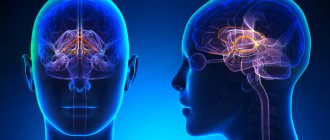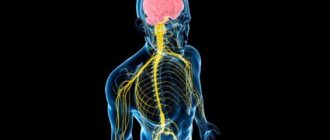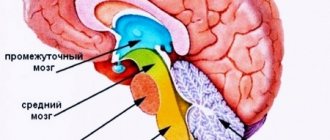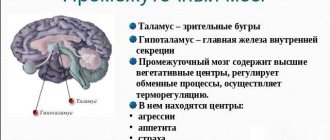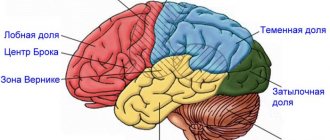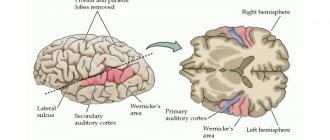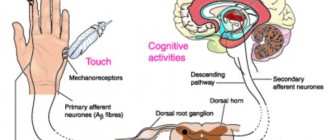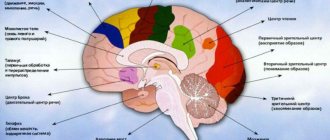Man is the only species on earth that, in addition to satisfying the needs dictated by instincts, is capable of carrying out emotional, creative and mental activities. The uniqueness of people lies in the presence of extensive, highly developed and complexly constructed areas of the brain, which have the general name neocrtex. Therefore, in the study of man, as a species at the upper stage of evolution, the main directions are questions about the structure and functions of this part of the central nervous system.
General information
The neocortex (new cortex, isocortex or lat. neocortex) is an area of the cerebral cortex, occupying about 96% of the surface of the hemispheres and having a thickness of 1.5 - 4 mm, which are responsible for the perception of the surrounding world, motor skills, thinking and speech.
The neocortex consists of three main types of neurons - pyramidal, stellate and fusiform. The first, the most numerous group, which makes up about 70-80% of the total amount in the brain. The proportion of stellate neurons is at the level of 15-25%, and fusiform neurons - about 5%.
In its structure, the neocortex is almost homogeneous and consists of 6 horizontal layers and vertical columns of the cortex. The layers of the new cortex have the following structure:
- Molecular, consisting of fibers and a small number of small stellate neurons. The fibers form a tangential plexus.
- The outer granular layer is formed by small neurons of various shapes, which are connected to the molecular layer over the entire area. At the very end of the layer there are small pyramidal cells.
- External pyramidal, consisting of small, medium and large pyramidal neurons. The processes of these cells can be associated with both layer 1 and the white matter.
- Internal granular, which consists mainly of stellate cells. This layer is characterized by a loose arrangement of neurons.
- Internal pyramidal, formed by medium and large pyramidal cells, the processes of which are connected with all other layers.
- Polymorphic, the basis of which is made up of spindle-shaped neurons, connected by processes with layer 5 and white matter.
In addition, the neocortex is divided into areas, which in turn are subdivided into Brodmann areas. The following areas are distinguished:
- Occipital (17,18 and 19 fields).
- Superior parietal (5 and 7).
- Inferior parietal (39 and 40).
- Postcentral (1, 2, 3 and 43).
- Precentral (4 and 6).
- Frontal (5, 9, 10, 11, 12, 32, 44, 45, 46 and 47).
- Temporal (20, 21, 22, 37, 41 and 42).
- Limbic (23, 24, 25 and 31).
- Ostrovkovaya (13 and 14).
The cortical columns are a group of neurons that are located perpendicular to the cerebral cortex. Within a small column, all cells perform the same task. But a hypercolumn, consisting of 50-100 mini-columns, can have one or many functions.
Neocortex
The neocortex is a part of the brain found in higher mammals. The rudiments of the neocortex are also observed in lower animals that suck milk, but they do not reach high development. In humans, the isocortex is the lion's part of the general cerebral cortex, having an average thickness of 4 millimeters. The area of the neocortex reaches 220 thousand square meters. mm.
History of origin
At the moment, the neocortex is the highest stage of human evolution. Scientists were able to study the first manifestations of the neobark in representatives of reptiles. The last animals in the chain of development without a new cortex were birds. And only humans have a developed neural system.
Evolution is a complex and long process. Every species of creature goes through a harsh evolutionary process. If an animal species was unable to adapt to a changing external environment, the species lost its existence. Why was man able to adapt and survive to this day?
Being in favorable living conditions (warm climate and protein foods), human descendants (before the Neanderthals) had no choice but to eat and reproduce (thanks to the developed limbic system). Because of this, the mass of the brain, by the standards of the duration of evolution, gained a critical mass in a short period of time (several million years). By the way, the brain mass in those days was 20% greater than that of a modern person.
However, all good things come to an end sooner or later. With a change in climate, descendants needed to change their place of residence, and with it, start looking for food. Having a huge brain, descendants began to use it to find food, and then for social involvement, because. It turned out that by uniting into groups according to certain behavioral criteria, it was easier to survive. For example, in a group where everyone shared food with other members of the group, there was a greater chance of survival (Someone was good at picking berries, someone was good at hunting, etc.).
Important Mnestic processes
From that moment on, a separate evolution of the brain began, separate from the evolution of the whole body. Since those times, a person’s appearance has not changed much, but the composition of the brain is radically different.
What does it consist of?
The neocortex is a collection of nerve cells that form complex gray matter. Anatomically, there are 4 types of cortex, depending on its location - parietal, occipital, frontal, temporal. Histologically, the cortex consists of six balls of cells:
- Molecular ball;
- external granular;
- pyramidal neurons;
- internal granular;
- ganglion layer;
- multiform cells.
What functions does it perform?
The human neocortex is classified into three functional areas:
- Sensory. This zone is responsible for higher processing of received stimuli from the external environment. So, ice becomes cold when information about the temperature arrives in the parietal region - on the other hand, there is no cold on the finger, but only an electrical impulse.
- Association zone. This area of the cortex is responsible for information communication between the motor cortex and the sensitive one.
- Motor zone. All conscious movements are formed in this part of the brain. In addition to such functions, the neocortex provides higher mental activity: intelligence, speech, memory and behavior.
Functions of neocortex
The new cortex is responsible for performing higher nervous functions (thinking, speech, processing information from the senses, creativity, etc.). Clinical trials have shown that each area of the cerebral cortex is responsible for strictly defined functions. For example, human speech is controlled by the left frontal gyrus. However, if any of the areas is damaged, the neighboring one can take over its function, although this requires a long period of time. Conventionally, there are three main groups of functions performed by the neocortex - sensory, motor and associative.
Sensory
This group includes a set of functions with the help of which a person is able to perceive information from the senses.
Each sense is analyzed by a separate area, but signals from others are also taken into account.
Signals from the skin are processed by the posterior central gyrus. Moreover, information from the lower extremities goes to the upper part of the gyrus, from the body to the middle part, from the head and hands to the lower part. In this case, the posterior central gyrus processes only pain and temperature sensations. The sense of touch is controlled by the superior parietal region.
Vision is controlled by the occipital region. Information is received in field 17, and in fields 18 and 19 it is processed, that is, color, size, shape and other parameters are analyzed.
Hearing is processed in the temporal region.
Charm and taste sensations are controlled by the hippocampal gyrus, which, unlike the general structure of the neocortex, has only 3 horizontal layers.
It is worth noting that in addition to the zones of direct reception of information from the senses, next to them there are secondary ones, in which the relationship between the received images and those stored in memory occurs. When these areas of the brain are damaged, a person completely loses the ability to recognize incoming data.
Motor
This group includes the functions of the neocortex, with the help of which any movement of the human limbs is carried out. Motor skills are controlled and controlled by the precentral region. The lower limbs depend on the upper parts of the central gyrus, and the upper limbs depend on the lower ones. In addition to the precentral, the frontal, occipital and superior parietal regions are involved in movement. An important feature of the performance of motor functions is that they cannot be performed without constant connections with sensory areas.
Associative
This group of neocortical functions is responsible for such complex elements of consciousness as thinking, planning, emotional control, memory, empathy and many others.
Associative functions are performed by the frontal, temporal and parietal regions.
In these areas of the brain, a reaction to data coming from the senses is formed and command signals are sent to the motor and sensory areas.
To receive and control, all sensory and motor areas of the cerebral cortex are surrounded by associative fields, in which the received information is analyzed. But at the same time, it is worth considering that the data coming into these fields is already primarily processed in the sensory and motor areas. For example, if there is a disruption in the functioning of such an area in the visual area, a person sees and understands that there is an object, but cannot name it and, accordingly, make a decision about his further behavior.
In addition, the frontal lobe of the cortex is very tightly connected to the limbic system, which allows it to control and manage emotional messages and reflexes. This makes it possible for a person to develop as a person.
The performance of associative functions in the neocortex is possible due to the fact that the neurons of this part of the central nervous system are able to retain traces of excitation based on the feedback principle and can persist for a long time (from several years to a lifetime). This ability is memory, with the help of which associative connections of the information received are built.
What functions does the neocortex perform?
Neocortex, or gray matter
The neocortex contains over fifteen billion neurons (nerve cells) - and each such cell has the capabilities of a computer. It is thanks to their incredible properties that we can move around, communicate with people, store a bunch of information in memory that can be used at the right time - numbers, phone numbers, addresses, dates, as well as a huge vocabulary, the taste of various foods, various sounds and etc.
The neocortex consists of two cerebral hemispheres: the right and left.
In short, the left hemisphere of the brain is responsible for the rational - for example, reading, speaking, counting, reasoning, analyzing a situation, making connections. It is associated with logical thinking and corresponds to the giving masculine principle, yang. It controls the right side of our body.
The right hemisphere processes information about emotions and feelings. Thanks to him, we understand the situation and give it an emotional or sensory coloring (what we feel). It is associated with imagination, intuition, and also with dreams. It is responsible for our receptive feminine principle, yin, and governs the left side of the body.
The two hemispheres are connected by the corpus callosum, through which they can exchange information. For example: the phone rings, I answer. The right hemisphere allows me to recognize the caller's voice and determine whether he is calm or worried. I can talk to this person using the left hemisphere. If a stranger calls, based on the tone of his voice and based on my feelings (right hemisphere), I will treat him with sympathy or antipathy.
The interaction of the two hemispheres of the brain and the conclusion they come to will determine my actions: will I continue the conversation or hang up the phone.
Thus, the neocortex performs the following functions:
1. Acceptance of information.
2. Analysis and reasoning (left hemisphere), general perception and sensation (right hemisphere).
3. Memorizing facts and knowledge: colors, letters of the alphabet, numbers, arts and sciences, etc.
The neocortex is the seat of intelligence. Its main role is recognition, it is thanks to it that we can make choices every day. And depending on a favorable or unfavorable choice, an experience is formed that allows us to grow spiritually.
The role of the neocortex in emotions and stereogynesis
Emotions in humans initially appear in the limbic system of the brain. But in this case they are represented by primitive concepts, which, once in the new cortex, are processed using the associative function. As a result, a person can operate with emotions at a higher level, which makes it possible to introduce concepts such as joy, sadness, love, anger, etc.
The neocortex also has the ability to dampen strong outbursts of emotion in the limbic system by sending calming signals to areas of high neuronal excitability. This leads to the fact that in a person the dominant role in behavior is played by the mind, and not by instinctive reflexes.
Fabric structure
In humans and large mammals, the cerebral cortex folds, providing an impressive surface area in the limited volume of the skull. This compact arrangement plays a key role in brain conduction and functional organization.
The ridge, or fold, in the cortical tissue is called the gyrus, and the groove is called the sulcus. These structural elements appear during fetal development and then continue to develop after birth through the process of gyrification. The main part of the cortex is hidden in the grooves and is not visible from the outside. Neurons, of which there are from 14 to 16 billion in the cortex, are organized into columns and minicolumns.
The cerebral cortex is arranged in such a way that a large surface area of nervous tissue must fit within the neurocranium. If the cortical layer is expanded, it turns out that there is approximately 0.12 square meters of it on each hemisphere. Some mammals, for example, rodents, have a completely smooth surface of the brain, that is, no convolutions or grooves at all.
The thickness of the cortical layer is not always the same, for example, the sensory layer is thinner than the motor layer. In early studies, neuroscientists argued that the thickness of the cortex was directly related to intelligence. Some scientists have suggested that the somatosensory layers of the cerebral cortex are thicker in people suffering from migraine. However, later work completely refuted this theory.
Types of cortex
The surface of the cerebral hemispheres is formed by the cortex, which has a laminar organization. That is, the tissues in it are arranged in layers. The skin and bone membrane have a similar organizational structure. Based on the number of layers, it is customary to distinguish:
- The neocortex (isocortex, neopallium) is the largest, most evolutionarily mature part of the cortex with six different layers. An example of a neocortical area is the visual and motor cortex. This type, in turn, has two subtypes: true isocortex, proisocortex.
- The allocortex consists of three or four layers. In evolutionary terms, this is a more ancient, in some sense primitive area, located in the middle temporal lobes. It is associated with the sense of smell and survival functions, as well as visceral and emotional reactions. And here there are two subtypes: the paleocortex with three cortical plates, the archicortex with four or five. The first includes the piriformis lobe, which specializes in the sense of smell, the second consists of the hippocampus, which is involved in encoding verbal memory and spatial functions.
Important Numbness, goosebumps in the head, panic, anxiety, please help
The structure of the neocortex
Since the isocortes predominates, it is worth taking a closer look at its structure. So, six cortical layers, each of which contains a characteristic distribution of various neurons, as well as their connections with the cortical and subcortical areas.
I is a molecular layer that contains few neurons. II - external granular. III - outer pyramidal layer. IV - internal granular. V - internal pyramidal. VI - polymorphic (multiform) layer.
The cortical layers do not just lie on top of each other, they all have connections that span the entire thickness of the cortex. These chips are grouped into columns and mini-columns. The structure and functions of the cerebral cortex provide for its participation in the performance of various cognitive and behavioral responsibilities. The cortex, like the rest of the brain, receives oxygen, glucose and other nutrients through the blood that flows through the cerebral arteries. And veins carry carbon dioxide and metabolic waste from the brain to the heart.
Differences from old bark
The old cortex (archicortex) is an earlier emerging part of the cerebral cortex than the neocortex. But in the process of evolution, the new cortex became more developed and extensive. In this regard, the archicortex ceased to play a dominant role and became one of the constituent parts of the limbic system.
If we compare the old one in terms of the functions performed, then the first is assigned the role of fulfilling innate reflexes and motivation, and the second - managing emotions and actions at a higher level.
In addition, the neocortex is significantly larger in size than the old cortex. So the first occupies about 96% of the total surface of the hemispheres, and the size of the second is no more than 3%. This ratio shows that the archicortex cannot perform higher nervous functions.
Neocortex - rational brain
Hide advertisements in article
Neocortex - rational brain
The newest outer part of the brain is the neocortex, or rational brain. It is the pinnacle of brain evolution and the seat of free will and conscious awareness. It is responsible for our higher cognitive functions (speech, writing, problem solving), and also controls analytical and mathematical thinking. The neocortex, also called the neocortex, or simply the cortex for short, is made up of numerous folds and grooves divided into the right and left hemispheres. The right hemisphere is responsible for spatial imagination, creativity and abstract thinking, while the left hemisphere thinks more linearly, rationally, using words. The emotional brain determines significance, and the neocortex gives rational meaning to the feelings and emotions generated by the deeper, subconscious parts of the brain, trying to explain the causes and consequences of our sensations.
MacLean called the cerebral cortex “the mother of creativity and the father of abstract thinking.” This part of the brain includes the prefrontal cortex, the most developed and complex part of the brain, which distinguishes humans from other living things. The prefrontal cortex gives us the ability to plan behavior or create new possibilities by functioning as a mental stimulator of different realities, thanks to which we can imagine and anticipate the consequences of our actions. The prefrontal cortex allows us to understand, without testing, that heavier-than-air craft can fly and that liver-flavored ice cream is a bad idea.
The prefrontal cortex is also responsible for logic and comparative analysis, as exemplified by the dialogue in our heads. When we walk past the shelves in a store, an inner voice reasons: “Should I take this or that?” The ability to anticipate positive and negative outcomes enables conscious action and intelligent choice, and guides moral choices, such as when we suppress inappropriate physical needs. The prefrontal cortex also allows us to think first and act later, such as when the rational brakes kick in, preventing us from buying a BMW convertible, a $2,500 Gucci handbag, or eating another Godiva chocolate bar.
In addition, this part of the brain forms a sense of one’s own “I”, personality, and a conscious idea of oneself. It makes it possible to know that the reflection in the mirror is really you, and, as a repository of personality, it determines our place in the social hierarchy and how we present ourselves to the world around us.
In the process of evolution, the rational brain appeared last and plays a major role in higher order thinking. He comprehends and organizes the world, rationally interprets objects, gives conscious, subjective meaning to feelings and unconscious reactions. Nevertheless, this pinnacle of brain evolution has minimal influence on our behavior and is not always involved and necessary for action.
When you solve a crossword puzzle, compare information on product labels, learn a foreign language using Rosetta Stone, or decide to go to Las Vegas for a week, you are actively using your neocortex, or rational brain. We often appeal to the rational brain in marketing when we present facts and figures to audiences, such as to compare brands. Although these logical facts themselves are not the primary causes of motivation, they play an important role in giving permission to be guided in one's actions by emotions or physical needs. Thus, in advertising and marketing, rational information plays a secondary, but nevertheless important role. However, in some cases, a rational approach, such as a strong emphasis on frugality, can work wonders for new brands that do not have the high emotional charge of established competitors.
Several years ago, when I was doing strategic planning for the telecommunications company MCI (now Verizon) at the New York office of Euro RSCG, one of the first things I noticed was how smart, sustainable means (such as "Five" plans) cents on Sundays" or "Friends and Family," offering discounts to frequent callers) effectively challenged AT&T's monopoly, undermining its position. AT&T was comfortable, positioning itself as a leading, well-known, socially connected brand, but MCI focused on cost-effectiveness.
Important ECG online transcript with data entry
Book table of contents
